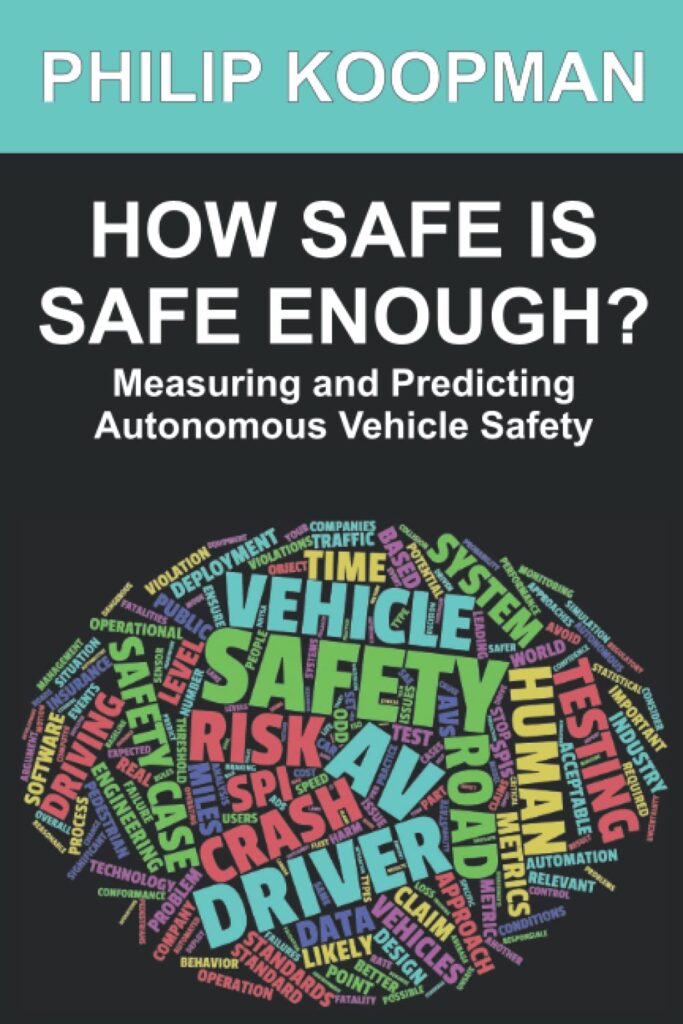autonomous vehicle safety: Imagine a world where the hustle and bustle of traffic flows smoothly without the sound of car horns, where road rage is a thing of the past, and where the term ‘accident’ is almost obsolete. This is the promise of autonomous vehicle technology—a future where cars drive themselves, and safety is paramount.
In this blog post, we delve into the realm of autonomous vehicles (AVs), marvels of modern engineering that are poised to revolutionize our roads. As these vehicles move from the drawing boards to our driveways, the question of safety takes center stage. How can we ensure that these driverless cars are safe for passengers, pedestrians, and other road users?
The answer lies in the intricate web of safety standards that govern the development and operation of AVs. From the algorithms that make split-second decisions to the sensors that map the world around them, every aspect of an autonomous vehicle is designed with safety in mind.
Join us as we explore the cutting-edge technology that makes AVs tick, the regulations that keep them in check, and the challenges that lie ahead in our journey toward a safer, autonomous future.
table of contents:
- The Evolution of Autonomous Vehicle Safety: Tracing the journey from seat belts to AI, highlighting the milestones in vehicle safety.
- Key Safety Features in Autonomous Vehicles: Unveiling the tech that makes AVs the new standard in road safety.
- Safety Standards and Regulations: Examining the legal landscape shaping the safe deployment of AVs.
- Challenges and Considerations: Addressing the technological, ethical, and infrastructural hurdles facing AVs.
- The Future of Autonomous Vehicle Safety: Envisioning the advancements and impact of AVs on global safety standards.
- Conclusion: Reflecting on the collaborative journey towards a safer autonomous future.
How Safe Is Safe Enough?: Measuring and Predicting Autonomous Vehicle Safety Paperback – September 2, 2022

The Evolution of Autonomous Vehicle Safety
The journey towards autonomous vehicles is paved with a history of innovation and a steadfast commitment to safety. The evolution of vehicle safety has been a relentless pursuit, marked by milestones that have set the stage for today’s autonomous marvels.
The Early Days: Mechanical Ingenuity In the early 20th century, vehicle safety was rudimentary, focusing on mechanical solutions to physical challenges. Crumple zones, seat belts, and padded dashboards were revolutionary, providing passive safety features that protected occupants in the event of a crash.
The Rise of Active Safety As technology advanced, active safety features began to emerge. Anti-lock braking systems (ABS) and electronic stability control (ESC) became standard, actively preventing accidents by giving drivers better control over their vehicles, thereby enhancing autonomous vehicle safety.
The Digital Revolution: Driver Assistance Systems The digital age has heralded a myriad of driver assistance technologies, aimed at enhancing road safety and minimizing human error. Features such as adaptive cruise control, lane-keeping assist, and automatic emergency braking utilize advanced sensors and computing power to alleviate the burden on drivers and enhance overall driving experience. These innovations represent significant strides towards enhancing autonomous vehicle safety, promising to revolutionize transportation by reducing accidents and fatalities on the road.
The Dawn of Autonomy: Automated Driving Systems (ADS) Today, we stand on the brink of a new era with Automated Driving Systems (ADS). These systems represent the culmination of safety evolution, aiming to remove the human error factor entirely from driving. The National Highway Traffic Safety Administration (NHTSA) has been instrumental in shaping the safety landscape for ADS-equipped vehicles.
Setting New Standards The NHTSA recently updated the Federal Motor Vehicle Safety Standards (FMVSS) to include specific requirements for autonomous vehicles. This includes changes in terminology to reflect the spatial layout of automated vehicles, which may lack traditional features like steering wheels or driver’s seats. The IEEE has also contributed to the P2846 Draft Standard, defining a minimum set of assumptions for safety-related automated vehicle behavior.
Global Perspectives Internationally, the United Nations Economic Commission for Europe (UNECE) has proposed comprehensive guidelines outlining safety requirements for Autonomous Driving Systems (ADS). This initiative underscores the global consensus regarding the paramount importance of safety in the advancement and deployment of autonomous vehicles. By establishing standardized safety protocols, UNECE aims to ensure that autonomous vehicles meet rigorous safety standards, thus fostering public trust and confidence in this transformative technology. The implementation of these guidelines represents a crucial step towards enhancing autonomous vehicle safety on a global scale, facilitating the widespread adoption of this innovative mode of transportation.
Safety as a Priority As we move forward, the priority remains clear: autonomous vehicle safety must be integrated from the beginning. Whether it’s through rigorous testing, robust standards, or public education, the goal is to ensure that autonomous vehicles not only match but exceed the safety levels of human-driven cars.
Amazon Basics Emergency Seat Belt Cutter and Window Hammer Tool, Car Accessories, 2 Pack

Key Safety Features in Autonomous Vehicles
The promise of autonomous vehicles (AVs) lies not just in their ability to drive without human intervention, but in their potential to drastically reduce the number of accidents on our roads. This potential is hinged on a suite of advanced safety features that are the bedrock of AV technology.
Sensors and Machine Perception At the heart of an AV’s safety arsenal is an array of sensors that provide 360-degree coverage around the vehicle. Cameras, radar, ultrasonic sensors, and lidar work in concert to create a detailed map of the vehicle’s surroundings. This sensor fusion allows AVs to detect and respond to objects, pedestrians, and other vehicles with superhuman speed and precision.
Emergency Braking Systems Emergency braking systems in AVs are designed to prevent collisions before they happen. By constantly monitoring the distance to objects ahead, AVs can engage brakes faster than a human ever could, significantly reducing the severity of accidents or avoiding them altogether.
Lane Control and Steering Automation Lane control technologies ensure that AVs stay within their designated lanes, making minute adjustments to the steering to maintain a central position. This continuous steering assistance helps prevent one of the most common causes of accidents: unintended lane departures.
Cross-Car Communication A futuristic feature that is rapidly becoming a reality is vehicle-to-vehicle (V2V) communication. By sharing information about their speed, direction, and any detected hazards, AVs can coordinate with each other to optimize traffic flow and enhance autonomous vehicle safety.
Advanced Windshield Technologies The windshields of AVs are more than just a piece of glass; they serve as a platform for integrating advanced technologies. For example, Tesla’s Model 3 features a lightweight, durable windshield that enhances visibility and integrates with the vehicle’s sensor systems.
Challenges to Overcome Despite the impressive advancements in safety features, Autonomous Vehicles (AVs) encounter formidable challenges. The intricacies of real-world driving environments, the necessity for extensive testing, and the refinement of dependable machine-learning algorithms remain ongoing focal points of research and development. Moreover, the seamless integration of these systems into existing infrastructure and their interaction with human-driven vehicles pose additional obstacles that must be surmounted to unlock the full safety potential of AVs. Addressing these challenges is imperative to ensure the safe and successful deployment of autonomous vehicles, thereby realizing their promise of revolutionizing transportation while prioritizing autonomous vehicle safety.
MOTOPOWER MP0515A 12V Car Battery Tester Automotive 100-2000 CCA Battery Load Tester Auto Cranking and Charging System Test Scan Tool Digital Battery Alternator Analyzer

Safety Standards and Regulations
The advent of autonomous vehicles (AVs) brings forth a paradigm shift not only in how we travel but also in how we regulate and ensure the safety of our transportation systems. As AVs prepare to take to the streets, a robust framework of safety standards and regulations is crucial to safeguard the public.
Navigating the Regulatory Landscape The regulatory landscape for AVs is complex and multifaceted. In the United States, the National Highway Traffic Safety Administration (NHTSA) has issued the Federal Automated Vehicles Policy, which provides a blueprint for the safe development and deployment of AVs. This policy outlines best practices and guidance for manufacturers and developers, ensuring that AVs meet rigorous safety standards before hitting the road.
International Standards Globally, the United Nations Economic Commission for Europe (UNECE) has established regulations that apply to AVs, setting international standards for vehicle safety and automated systems. These regulations are adopted by many countries and serve as a benchmark for AV safety worldwide.
The European Approach The European Union has demonstrated proactive measures in addressing Autonomous Vehicle (AV) safety concerns. The revised General Safety Regulation, which came into effect in July 2022, mandates the incorporation of advanced driver assistance systems and establishes a robust legal framework for the approval and regulation of driverless and automated vehicles across the EU. By implementing stringent safety standards and regulatory protocols, the EU aims to ensure the safe integration and operation of AVs on European roads. This proactive approach underscores the EU’s commitment to fostering innovation while prioritizing the safety of both passengers and pedestrians.
The UK’s Direction The United Kingdom is forging ahead with new legislation aimed at facilitating the safe deployment of self-driving vehicles on British roads. These laws mandate that Autonomous Vehicles (AVs) undergo rigorous safety testing before being authorized to operate on UK roads. Additionally, clear legal liability frameworks are being established to delineate responsibility when a vehicle is driving autonomously. By implementing these measures, the UK is laying the groundwork for the safe and responsible integration of AVs into its transportation network, fostering public trust and confidence in this transformative technology.
Challenges Ahead Despite these efforts, challenges remain. Defining and measuring safety for AVs is a primary concern, as traditional metrics used for human-driven vehicles may not apply. Additionally, the technology’s rapid advancement outpaces the slower legislative processes, creating a gap that must be bridged through continuous dialogue and updates to regulations.
Ethical Considerations Another layer of complexity is added by the ethical considerations unique to AVs. Decisions that were once in the hands of human drivers now fall to algorithms, raising questions about how these machines will make moral judgments in critical situations.
A Collaborative Effort To effectively navigate the challenges surrounding autonomous vehicle safety, collaboration among various stakeholders is paramount. Industry players, regulators, safety organizations, and the public must work together synergistically. Initiatives such as data-sharing agreements and pilot programs play a crucial role in managing risks associated with autonomous vehicle technology while simultaneously fostering its development. By pooling resources, expertise, and insights, these collaborative efforts can expedite progress in enhancing safety standards, ensuring responsible deployment, and building public confidence in autonomous vehicles.
Car Emergency Roadside Kit- Safety Kits for Cars, Car Jumper Cables Kit 11.8 Foot (Upgrade) 124 Pcs Car Tool Kit,Tow Strap, Folding Survival Shovel

Challenges and Considerations
As the automotive industry accelerates towards a future dominated by autonomous vehicles (AVs), it faces a myriad of challenges and considerations that must be addressed to ensure the safety and reliability of these vehicles.
Technological Hurdles one of the foremost challenges facing the widespread adoption of Autonomous Vehicles (AVs) is the inherent technological complexity they entail. Guaranteeing that these vehicles can consistently interpret and react to an ever-changing and unpredictable environment represents a monumental task. Critical components such as sensor reliability, robust data processing capabilities, and sophisticated machine learning algorithms must be perfected to enable AVs to navigate through every conceivable scenario they might encounter on the road. This pursuit demands relentless innovation, extensive testing, and iterative refinement to ensure the utmost reliability and safety of autonomous vehicle systems.
Cybersecurity Concerns With AVs heavily reliant on software, cybersecurity becomes a critical safety issue. Protecting vehicles from hacking and ensuring the integrity of their operational software is paramount. A breach could have catastrophic consequences, not just for individual vehicles but for entire fleets.
Ethical Dilemmas AVs also present unique ethical dilemmas. In situations where an accident is unavoidable, how should an AV decide what action to take? The programming of these “moral algorithms” is a subject of intense debate and research.
Infrastructure Adaptation The integration of Autonomous Vehicles (AVs) into existing infrastructure necessitates adaptations to accommodate their operation effectively while prioritizing autonomous vehicle safety. This includes upgrading roads, traffic signals, and parking facilities to facilitate seamless communication with AVs and support their navigation and interaction within the transportation network. Such enhancements require substantial investment and coordination among various stakeholders, including government agencies, urban planners, transportation authorities, and technology providers. By working collaboratively to modernize infrastructure, stakeholders can unlock the full potential of AV technology, enhancing safety, efficiency, and accessibility in transportation systems of the future.
Legal and Regulatory Frameworks Current legal and regulatory frameworks are not fully prepared for AVs. Laws and regulations will need to evolve to address liability in the event of an accident, certification processes for AVs, and the transition period where human-driven and autonomous vehicles will share the road.
Public Acceptance and Perception Public perception and acceptance of AVs will play a crucial role in their adoption. Overcoming skepticism and fear associated with surrendering control to a machine is a challenge that must be met with transparency, education, and the gradual introduction of technology.
Economic and Employment Impact The widespread adoption of Autonomous Vehicles (AVs) is poised to have profound economic implications, particularly in terms of employment. Traditional driving-related occupations may undergo substantial transformation or even become obsolete as AV technology advances. However, this shift will also give rise to new employment opportunities, particularly in emerging sectors such as fleet management and software development tailored to autonomous vehicle safety. While the transition may pose challenges for displaced workers, proactive measures such as retraining programs and workforce development initiatives can help mitigate the impact and ensure that individuals are equipped with the skills needed to thrive in the evolving job market spurred by AV innovation.
Environmental Considerations AVs have the potential to reduce emissions and improve fuel efficiency. However, the environmental impact of producing and recycling the advanced batteries and sensors used in AVs must also be considered.
Slime 50122 Flat Tire Puncture Emergency Kit, Includes Sealant and Tire Inflator Pump, Analog, Suitable for Cars and Other Highway Vehicles, 10 Min Fix

The Future of Autonomous Vehicle Safety
The road to fully autonomous vehicles is not just an advancement of technology; it’s a journey towards a transformative shift in how we perceive and ensure safety on our roads. As we look to the future, several key areas will shape the safety of autonomous vehicles.
Advancements in Technology The ongoing enhancement of sensors, machine learning algorithms, and computing power represents a pivotal advancement in the capabilities of Autonomous Vehicles (AVs) to navigate intricate environments with heightened accuracy and reliability, crucial for ensuring autonomous vehicle safety. Innovations such as high-definition mapping and refined object recognition algorithms are poised to play a central role in this evolution. These technological advancements empower AVs to perceive and interpret their surroundings with unprecedented precision, enabling them to make informed decisions and navigate complex scenarios with confidence. As these innovations continue to mature, the potential for AVs to operate safely and efficiently in diverse real-world conditions will significantly increase, paving the way for broader adoption and integration into mainstream transportation systems.
Hybrid Systems and Human Oversight One potential path forward is the development of hybrid systems, where autonomous vehicles handle routine scenarios independently, while more complex situations are managed by remote human operators. This approach could bridge the gap between current capabilities and full autonomy, ensuring safety without stalling progress.
Regulatory Evolution As autonomous vehicle technology progresses, regulations will need to keep pace. This includes updating safety standards, defining liability in the event of an accident, and ensuring that the transition to full autonomy is managed safely. International collaboration will be essential to create a consistent framework for AV safety.
Public Trust and Acceptance Building public trust is paramount for the widespread adoption of autonomous vehicles. This will require transparent communication about the capabilities and limitations of AVs, as well as demonstrable evidence of their safety benefits. Public education campaigns and open data initiatives could help in fostering this trust.
Ethical and Moral Decision-Making The programming of autonomous vehicles to make ethical decisions in unavoidable accident scenarios remains a complex challenge. The industry must engage in an ongoing dialogue with ethicists, policymakers, and the public to navigate these moral quandaries.
Infrastructure Compatibility The future of Autonomous Vehicle (AV) safety hinges not only on technological advancements within the vehicles themselves but also on the readiness of infrastructure to support their operation. Smart roads, advanced traffic management systems, and robust vehicle-to-infrastructure communication networks will be pivotal components in creating an environment where AVs can operate safely and efficiently. By integrating these elements, infrastructure can enhance situational awareness for AVs, provide real-time data on road conditions, and facilitate seamless coordination with other vehicles and traffic management systems. This infrastructure readiness is essential for maximizing the safety benefits of AVs and ensuring their successful integration into the broader transportation ecosystem.
Environmental Impact The potential environmental benefits of autonomous vehicles, such as reduced emissions and improved fuel efficiency, are significant. However, the production and disposal of advanced technologies used in AVs must also be environmentally sustainable.
Economic and Societal Impacts The adoption of autonomous vehicles will have far-reaching economic and societal impacts. Job markets will shift, urban planning may change, and the way we think about vehicle ownership could be transformed. Ensuring that these changes are positive for society as a whole is a critical aspect of AV safety.
B6350 Black/Red Fast Lift Service Jack – 3.5 Ton Capacity, 28 1/2″ L x 13 3/4″ W x 6 1/2″ H

conclusion:
As we stand on the brink of a new era in transportation, the emergence of autonomous vehicles presents an unprecedented opportunity to redefine road safety. While this journey is not devoid of challenges, the potential rewards are immense. Autonomous vehicle technology holds the promise of significantly reducing accidents, saving lives, and creating a more efficient transportation system.
Moving forward requires a concerted effort from manufacturers, policymakers, technologists, and the public alike. Together, we must navigate the complexities of technological innovation, ethical considerations, and regulatory frameworks. It’s imperative to construct infrastructure that can support these advanced vehicles and cultivate public trust through education and transparency.
The safety of autonomous vehicles isn’t a static objective but a dynamic process that evolves with each technological advancement and policy refinement. It’s our collective duty to ensure that this process is characterized by meticulous consideration, extensive testing, and an unwavering commitment to the highest safety standards.
As we embrace the future of autonomous vehicles, let’s do so with a vigilant focus on safety, an openness to innovation, and a steadfast determination to create a safer world for all road users.
You may also like:




